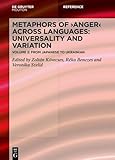Metaphors of ANGER across Languages : Universality and Variation. 8.2, Metaphors of ANGER across Languages: Universality and Variation ; Volume 2: From Japanese to Ukrainian / ed. by Zoltan Kövecses, Réka Benczes, Veronika Szelid.
Material type: TextSeries: Comparative Handbooks of Linguistics [CHL] ; 8.2Publisher: Berlin ; Boston : De Gruyter Mouton, [2024]Copyright date: 2025Description: 1 online resource (XII, 708 p.)Content type:
TextSeries: Comparative Handbooks of Linguistics [CHL] ; 8.2Publisher: Berlin ; Boston : De Gruyter Mouton, [2024]Copyright date: 2025Description: 1 online resource (XII, 708 p.)Content type: - 9783111558301
- 9783111560281
- 9783111559780
- 152.47
- online - DeGruyter
- Issued also in print.
| Item type | Current library | Call number | URL | Status | Notes | Barcode | |
|---|---|---|---|---|---|---|---|
 eBook
eBook
|
Biblioteca "Angelicum" Pont. Univ. S.Tommaso d'Aquino Nuvola online | online - DeGruyter (Browse shelf(Opens below)) | Online access | Not for loan (Accesso limitato) | Accesso per gli utenti autorizzati / Access for authorized users | (dgr)9783111559780 |
Frontmatter -- Purpose and Aim of the Series -- Contents -- List of Contributors -- Volume 2 -- 16 Anger in Japanese: “My bowels are boiling” -- 17 Anger in Kabyle: “I ate fire” -- 18 Anger in Korean: “A fireball rises up” -- 19 Anger in Polish: “Taken by the devil” -- 20 Anger in Romanian: “You are getting me out of my melons” -- 21 Anger in Russian: “To tease the geese” -- 22 Anger in Serbian: “A hundred devils under my skin” -- 23 Anger in Swahili: “I was caught by anger” -- 24 Anger in Thai: “A supernatural power shows its ability” -- 25 Anger in Turkish: “I turned into a jar of nerves” -- 26 Anger in Ukrainian: “He is getting into a bottle” -- 27 Conclusions -- Index
restricted access online access with authorization star
http://purl.org/coar/access_right/c_16ec
Anger is one of the basic emotions of human emotional experience, informing and guiding many of our choices and actions. Although it has received considerable scholarly attention in a number of disciplines, including linguistics, a basic question has still remained unresolved: why do variations in the folk model of anger exist across languages if it is indeed a basic emotion rooted in largely universal bodily experience? By drawing on a wide selection of comparable linguistic data from dozens of languages (including a number of less-researched languages), this volume provides the most comprehensive account of what is universal and what is variable in the folk model of anger – and why. It also investigates the role that metonymies might play in the emergence of anger-related metaphors and in what ways context influences or shapes anger metaphors and thereby the resulting folk model of anger. No such volume exists in the (cognitive) linguistic literature on anger – or on emotions for that matter. The book is thus an essential contribution to the study of anger and will serve as basic reading for any researcher interested in how the conceptualization of anger is constructed via the interplay of bodily experience, language and the larger cultural context.
Issued also in print.
Mode of access: Internet via World Wide Web.
In English.
Description based on online resource; title from PDF title page (publisher's Web site, viewed 20. Nov 2024)


